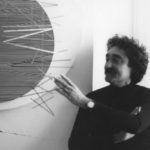Soto, Rafael Jesús

Jesús Rafael Soto was born in Ciudad Bolivar (Venezuela) in 1923. Soto is commonly associated with op art and his work is characterised by the continuous study of movement and the dematerialisation of form, producing constructions of a kinetic character in which the active participation of the spectator becomes key. He was undeniably influenced by Cubism and Constructivism, which were becoming popular in Latin America thanks to the work of important European artists.
In 1950 he moved to Paris, where he lived until his death, and where he formed part of \"Los Disidentes\", a group of artists from the Venezuelan diaspora who sought to renew the plastic arts in their country.
In France he discovered the work of Paul Klee and, above all, Piet Mondrian, with whom he set out to \"dynamise Neoplasticism\", which set the definitive course for his kinetic art and reached its peak. However, he did not neglect other artistic categories, sculpture being his greatest exponent.
His first kinetic works date from 1956, based on the idea of integrating the viewer into them by displacing the elements of the piece and thus playing with the viewer\'s perception. This immerses the viewer in the work, making him or her a participant in it. In the 1960s he also began to create large-scale designs in which he sought to integrate architecture as part of the decoration, such as the decoration of the interior of the UNESCO building in Paris (1970), the interior of the Georges Pompidou National Centre for Art and Culture in Paris (1976) and numerous public spaces in Caracas.
One of his best-known works is Houston Penetrable (1996), a fully walkable installation composed of 24,000 carefully painted PVC pipes suspended from a height of two floors with a total space of 241 square metres. It has been permanently on view at the Museum of Fine Arts Houston since 2014 after more than a decade in production, making it the artist\'s only permanent indoor installation.
The development of Jesús Soto\'s work began with perceptual kineticism, that is, black and white studies based on moiré effects, planes activated by colour and retinal vibration of lines provoked by the interaction between figure and background, to reach the total conquest of space. Between one point and another, Soto did not skimp on the exploration of phases and intermediate stages.
In 1988 he created the Virtual Sphere for the Olympic Sculpture Park in Seoul. In the 1990s he showed his work at the Museum of Modern Art in Kamakura, Japan (1990), at the Centre Georges Pompidou in Paris (1993), at the Kunshalle in Cologne, Germany (1993) and at the MOMA in New York (1993). One of the main museums of visual arts in Venezuela, located in his hometown, bears his name.
Soto died in Paris in 2005.


